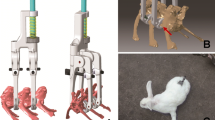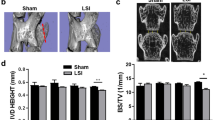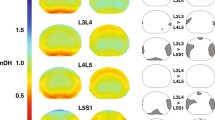Abstract
Mechanical stress on the intervertebral disc (IVD) may contribute significantly to IVD degeneration, although its pathomechanism has not been fully understood. The purpose of this study was to test the hypothesis that sustained application of static shear force would result in IVD degeneration with minimum injury. We applied shear force on the rat lumbar spine (L5–L6) using a custom-designed loading device for 1 or 2 weeks. Degenerative changes such as nucleus pulposus cavity loss and border disruption were observed from the histology sections, indicating that the application of sustained dorsoventral shear force on the L6 vertebra induced degeneration of the IVDs in L5–L6 and adjacent levels of motion segment in 1 and 2 weeks. The findings of the present study could be useful for gaining a more relevant understanding of the biomechanical load factors of IVD degeneration not only for enabling better therapeutic interventions but also reducing the risk of low back injury.




Similar content being viewed by others
References
Adams, M. A., and W. C. Hutton. The relevance of torsion to the mechanical derangement of the lumbar spine. Spine (Phila Pa 1976) 6(3):241–248, 1981.
Barbir, A., K. E. Godburn, A. J. Michalek, et al. Effects of torsion on intervertebral disc gene expression and biomechanics, using a rat tail model. Spine (Phila Pa 1976) 36(8):607–614, 2011.
Battie, M. C., T. Videman, and E. Parent. Lumbar disc degeneration: epidemiology and genetic influences. Spine 29(23):2679–2690, 2004.
Borenstein, D. Epidemiology, etiology, diagnostic evaluation, and treatment of low back pain. Curr. Opin. Rheumatol. 10(2):104–109, 1998.
Buckwalter, J. A. Aging and degeneration of the human intervertebral disc. Spine 20:1307–1314, 1995.
Ching, C. T., D. H. Chow, F. Y. Yao, et al. The effect of cyclic compression on the mechanical properties of the inter-vertebral disc: an in vivo study in a rat tail model. Clin. Biomech. (Bristol, Avon) 18(3):182–189, 2003.
Ching, C. T., D. H. Chow, F. Y. Yao, et al. Changes in nuclear composition following cyclic compression of the intervertebral disc in an in vivo rat-tail model. Med. Eng. Phys. 26(7):587–594, 2004.
Han, K., B. Youn, S. Yang, et al. Follower compressive load can be produced during flexion and extension postures with muscle force capacity 40 N. In: 54th Annual Meeting of the Orthopaedic Research Society, San Francisco, CA, 2008.
Hirsch, C., B. Ingelmark, and M. Miller. The anatomical basis for low back pain. Acta Orthop. Scand. 33:1–17, 1963.
Hsieh, A. H., and J. C. Lotz. Prolonged spinal loading induces matrix metalloproteinase-2 activation in intervertebral discs. Spine 28(16):1781–1788, 2003.
Hutton, W. C., T. M. Ganey, W. A. Elmer, et al. Does long-term compressive loading on the intervertebral disc cause degeneration? Spine 25(23):2993–3004, 2000.
Hutton, W. C., Y. Toribatake, W. A. Elmer, et al. The effect of compressive force applied to the intervertebral disc in vivo. A study of proteoglycans and collagen. Spine 23(23):2524–2537, 1998.
Hutton, W. C., S. T. Yoon, W. A. Elmer, et al. Effect of tail suspension (or simulated weightlessness) on the lumbar intervertebral disc: study of proteoglycans and collagen. Spine 27(12):1286–1290, 2002.
Iatridis, J. C., P. L. Mente, I. A. Stokes, et al. Compression-induced changes in intervertebral disc properties in a rat tail model. Spine 24(10):996–1002, 1999.
Kawakami, M., H. Hashizume, H. Nishi, et al. Comparison of neuropathic pain induced by the application of normal and mechanically compressed nucleus pulposus to lumbar nerve roots in the rat. J. Orthop. Res. 21(3):535–539, 2003.
Kim, K. W., T. H. Lim, J. G. Kim, et al. The origin of chondrocytes in the nucleus pulposus and histologic findings associated with the transition of a notochordal nucleus pulposus to a fibrocartilaginous nucleus pulposus in intact rabbit intervertebral discs. Spine (Phila Pa 1976) 28(10):982–990, 2003.
Kitano, T., J. E. Zerwekh, Y. Usui, et al. Biochemical changes associated with the symptomatic human intervertebral disk. Clin. Orthop. Relat. Res. 293:372–377, 1993.
Korpanty, B.A. Axial compressive properties of the rat intervertebral disc-A comparative study of lumbar levels. In: Biomedical Engineering, Iowa City, IA, 2006.
Kroeber, M. W., F. Unglaub, H. Wang, et al. New in vivo animal model to create intervertebral disc degeneration and to investigate the effects of therapeutic strategies to stimulate disc regeneration. Spine 27(23):2684–2690, 2002.
Lim, T., K. Han, B. Youn, et al. Maximum muscle force capacity affects the compressive follower load in the lumbar spine quiet standing posture. In: 52nd Annual Meeting of the Orthopaedic Research Society, Chicago, IL, 2006.
Lim, T. H., P. S. Ramakrishnan, G. L. Kurriger, et al. Rat spinal motion segment in organ culture: a cell viability study. Spine 31(12):1291–1297, 2006; (discussion 1298).
Lotz, J. C. Animal models of intervertebral disc degeneration: lessons learned. Spine 29(23):2742–2750, 2004.
Lotz, J. C., and J. R. Chin. Intervertebral disc cell death is dependent on the magnitude and duration of spinal loading. Spine 25(12):1477–1483, 2000.
Lotz, J. C., O. K. Colliou, J. R. Chin, et al. Compression-induced degeneration of the intervertebral disc: an in vivo mouse model and finite-element study. Spine 23(23):2493–2506, 1998.
Lotz, J. C., A. H. Hsieh, A. L. Walsh, et al. Mechanobiology of the intervertebral disc. Biochem. Soc. Trans. 30(Pt6):853–858, 2002.
MacLean, J. J., C. R. Lee, S. Grad, et al. Effects of immobilization and dynamic compression on intervertebral disc cell gene expression in vivo. Spine 28(10):973–981, 2003.
Marras, W. S., S. A. Ferguson, D. Burr, et al. Low back pain recurrence in occupational environments. Spine (Phila Pa 1976) 32(21):2387–2397, 2007.
Marras, W. S., M. J. Jorgensen, and K. G. Davis. Effect of foot movement and an elastic lumbar back support on spinal loading during free-dynamic symmetric and asymmetric lifting exertions. Ergonomics 43(5):653–668, 2000.
Marras, W. S., S. A. Lavender, S. E. Leurgans, et al. The role of dynamic three-dimensional trunk motion in occupationally-related low back disorders. The effects of workplace factors, trunk position, and trunk motion characteristics on risk of injury. Spine (Phila Pa 1976) 18(5):617–628, 1993.
Palmer, E. I., and J. C. Lotz. The compressive creep properties of normal and degenerated murine intervertebral discs. J. Orthop. Res. 22(1):164–169, 2004.
Panjabi, M. M. Low back pain and spinal instability. In: Low Back Pain, edited by J. N. G. Weinstein, and S. L. Gordon. Rosemont, IL: American Academy of Orthopaedic Surgeons, 1996, pp. 367–384.
Patwardhan, A. G., R. M. Havey, G. Carandang, et al. Effect of compressive follower preload on the flexion-extension response of the human lumbar spine. J. Orthop. Res. 21(3):540–546, 2003.
Patwardhan, A. G., R. M. Havey, A. J. Ghanayem, et al. Load-carrying capacity of the human cervical spine in compression is increased under a follower load. Spine 25(12):1548–1554, 2000.
Patwardhan, A. G., R. M. Havey, K. P. Meade, et al. A follower load increases the load-carrying capacity of the lumbar spine in compression. Spine 24(10):1003–1009, 1999.
Patwardhan, A. G., K. P. Meade, and B. Lee. A frontal plane model of the lumbar spine subjected to a follower load: implications for the role of muscles. J. Biomech. Eng. 123(3):212–217, 2001.
Rohlmann, A., S. Neller, L. Claes, et al. Influence of a follower load on intradiscal pressure and intersegmental rotation of the lumbar spine. Spine 26(24):E557–E561, 2001.
Salminen, J. J., M. O. Erkintalo, J. Pentti, et al. Recurrent low back pain and early disc degeneration in the young. Spine 24(13):1316–1321, 1999.
Stevens, J. W., G. L. Kurriger, A. S. Carter, and J. A. Maynard. CD44 expression in the developing and growing rat intervertebral disc. Dev. Dyn. 219:381–390, 2000.
Stokes, I. A., and J. C. Iatridis. Mechanical conditions that accelerate intervertebral disc degeneration: overload versus immobilization. Spine 29(23):2724–2732, 2004.
Vernon-Roberts, B. P., and C. J. Pirie. Degenerative changes in the intervertebral discs of the lumbar spine and their sequelae. Rhumatol. Rehabil. 16:13–21, 1977.
Walsh, A. J., and J. C. Lotz. Biological response of the intervertebral disc to dynamic loading. J. Biomech. 37(3):329–337, 2004.
Walter, B. A., C. L. Korecki, D. Purmessur, et al. Complex loading affects intervertebral disc mechanics and biology. Osteoarthr. Cartil. 19(8):1011–1018, 2011.
Zhang, Y. G., Z. M. Sun, J. T. Liu, et al. Features of intervertebral disc degeneration in rat’s aging process. J. Zhejiang Univ. Sci. B 10(7):522–527, 2009.
Acknowledgments
The invaluable advice from Gail Kurriger in some of the experimentation is gratefully acknowledged.
Author information
Authors and Affiliations
Corresponding author
Additional information
Associate Editor Sean S. Kohles oversaw the review of this article.
Rights and permissions
About this article
Cite this article
Kim, J., Yang, SJ., Kim, H. et al. Effect of Shear Force on Intervertebral Disc (IVD) Degeneration: An In Vivo Rat Study. Ann Biomed Eng 40, 1996–2004 (2012). https://doi.org/10.1007/s10439-012-0570-z
Received:
Accepted:
Published:
Issue Date:
DOI: https://doi.org/10.1007/s10439-012-0570-z




